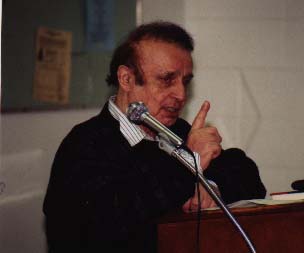
By Chad Kirkorian
Staff Writer
On January 28, 1999, Genocide and human rights scholar Dr. Vahakn Dadrian, was at Holy Trinity Armenian Apostolic Church, in Fresno, to introduce his new book, Warrant for Genocide: Key Elements of the Turko-Armenian Conflict. The lecture was co-sponsored by the Armenian Studies Program at California State University, Fresno, and the Armenian National Committee of Fresno.
Dr. Dadrian is a well known scholar whose field is Genocide studies, and specialization is the Armenian Genocide. He is the director of the Genocide Study Project sponsored by the H. F. Guggenheim Foundation. The project’s first major publication was The History of the Armenia Genocide, which is widely regarded as the seminal work on the Genocide.
Dr. Dadrian takes an interdisciplinary approach to develop an analytical understanding of the underlying causes for the Armenian Genocide. Dr. Dadrian has broken down the Turko-Armenian conflict into four main parts: the conceptual origin of conflict and Genocide, the heart of the Turko-Armenian conflict with regards to demographics and power relations, the transition from Armenian reform to revolution, and the key events which accelerated and intensified the conflict. During the course of the evening Dr. Dadrian was able to convey to the gathering all the factors and reasons for why the Genocide occurred.
According to Dr. Dadrian, “The Genocide was a violent resolution of a protracted conflict not solved by peaceful accommodation.” The origin of conflict and Genocide began under the Ottoman social structure which placed a dominant group with access to power over a minority group. Within the Ottoman Empire, society was organized by religious belief (millet system), which created a division between superior and inferior groups and which invited abuses of power. Christians, according to Islam, were entitled to protection and tolerance if they remained subservient and paid an exorbitant amount of taxes. Tax abuse occurred because the Ottoman government, in order to pay for their costly policy of perpetual war, demanded higher taxes from their non-Muslim citizens.
At the heart of the Turko-Armenian conflict was demography and power relations. In the aftermath of the Crimean war Muslims migrated from the Caucasus to Anatolia. The Russian Czar pushed the Chechen and the Circassian tribes into the region allowing them to play an important role in later massacres. There was also migration of Muslim refugees from the Balkans into the provinces of Van, Bitlis, and Kharpert, which eventually led to the worst atrocities committed against the Armenians. These refugees were filled with rage against the Christians who pushed them out and they displaced their aggression against the Armenians of Anatolia.
Another factor leading to the Genocide was Article 61 of the Treaty of Berlin 1878 which stated that reforms were needed in the eastern provinces to protect the Armenians against harassing Muslims. Sultan Abdul Hamid II knew that if the Armenians were reduced to a minority then reforms would be unnecessary. Therefore, Abdul Hamid II instituted a policy of redistributing populations within the empire. The Sultan rearranged boundaries and created new provinces. By attaching Muslim regions to major Armenian population centers he reduced the Armenians to minorities in those areas. The Sultan knew that if reforms were instituted in the Ottoman Empire, he would lose the eastern provinces just as he lost Greece, Serbia, and Bulgaria. Therefore, reforms were at the heart of the conflict because equality between Christians and Muslims was unacceptable to the Ottoman government, and Turks feared that the Armenians would take over the eastern provinces.
To perpetrate the Genocide, the Ottoman government had to control the power relation by depriving the Armenians of resources and access to power structures. The vulnerability factor invited the opportunity to execute violent and drastic measures. The Armenian minority was exposed to prejudice and legal discrimination. Armenians were denied access to significant positions of power. Commerce and trade were left as areas for Armenian development. This ascendancy to wealth by Armenians in many large cities was unacceptable to Turks during a period of economic hardship for most Muslims.
After the failure of the 1878 reforms, transition from reform to revolution developed later for the Armenians in relationship to the other Balkan peoples. While other minorities were rebelling, the Armenians still maintained the desire for law and order in the provinces instead of autonomy. However, impressed by the Balkan movement and in desperation and despair the Armenians started their revolutionary movement from 1885-1890.
The key events which accelerated and intensified the conflict began with the Young Turk coup in 1913, allowing them to gain access to all aspects of the Ottoman state institutions. Three sworn enemies of the Armenians took over the central committee: Dr. Nazim, Dr. Shakir, and Zia Gökalp. These men put forth a new policy of “Turkey for the Turks,” and attempted to purge all alien elements of society.
Those in attendance during Dr. Dadrian’s lecture were enlightened. Throughout the course of the evening, he provided an interesting lesson in Armenian history and shed some new light on the Armenian Genocide. Dr. Dadrian has provided a fresh new perspective on a subject that has been rigorously researched and developed.
 Hye Sharzhoom Armenian Action
Hye Sharzhoom Armenian Action